Abstract
1. The effects of neuropeptide Y (NPY) and a range of C terminal fragments were investigated both on basal short circuit current (s.c.c.) and electrical field stimulated responses in voltage clamped preparations in rat jejunal mucosa. 2. Most of the NPY fragments tested had direct effects upon the mucosa, reducing baseline s.c.c. with EC50 values of 1 micron or more. NPY was 30 times more effective than any of the fragments tested and the order of potency was: NPY much greater than NPY (11-36) greater than or equal to (12-36) greater than or equal to (13-36) greater than or equal to (14-36). NPY (15-36), (16-36), (20-36) and (22-36) were still less effective and complete concentration-response curves could not be constructed. NPY (26-36), des amido NPY and the C-terminal flanking peptide of NPY (CPON) were all inactive and did not significantly alter responses to NPY. 3. Electrical field stimulation (EFS) of mucosal preparations elicited rapid transient secretory responses in the presence of hexamethonium and atropine. NPY and fragments attenuated these secretory responses and where concentration-response relationships could be compared at a given time point the following order of potency was obtained: NPY much greater than NPY (11-36) greater than NPY (13-36). Again NPY (26-36), des amido NPY and CPON were ineffective, while at single concentrations (300 nM) a graded attenuation of EFS responses was obtained with NPY (14-36) greater than or equal to NPY (15-36) greater than NPY (16-36) greater than or equal to NPY (20-36) greater than NPY (22-36).(ABSTRACT TRUNCATED AT 250 WORDS)
Full text
PDF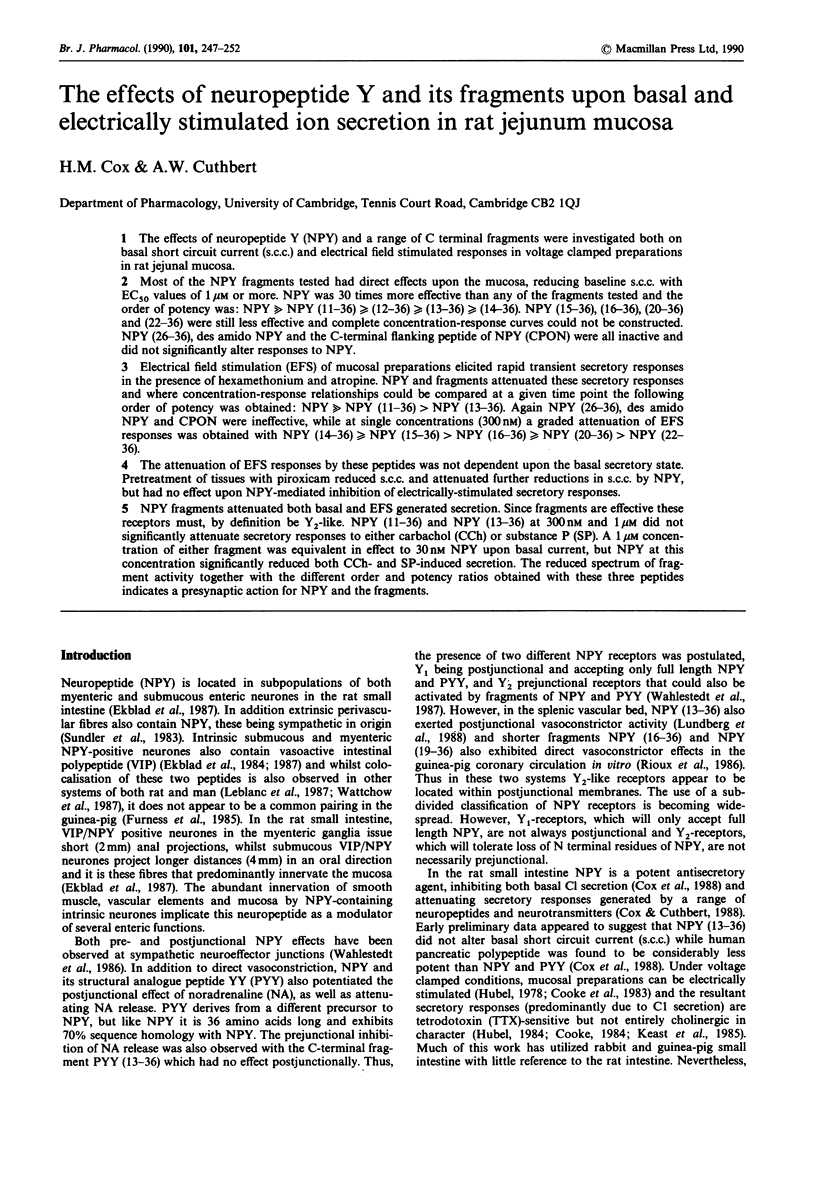
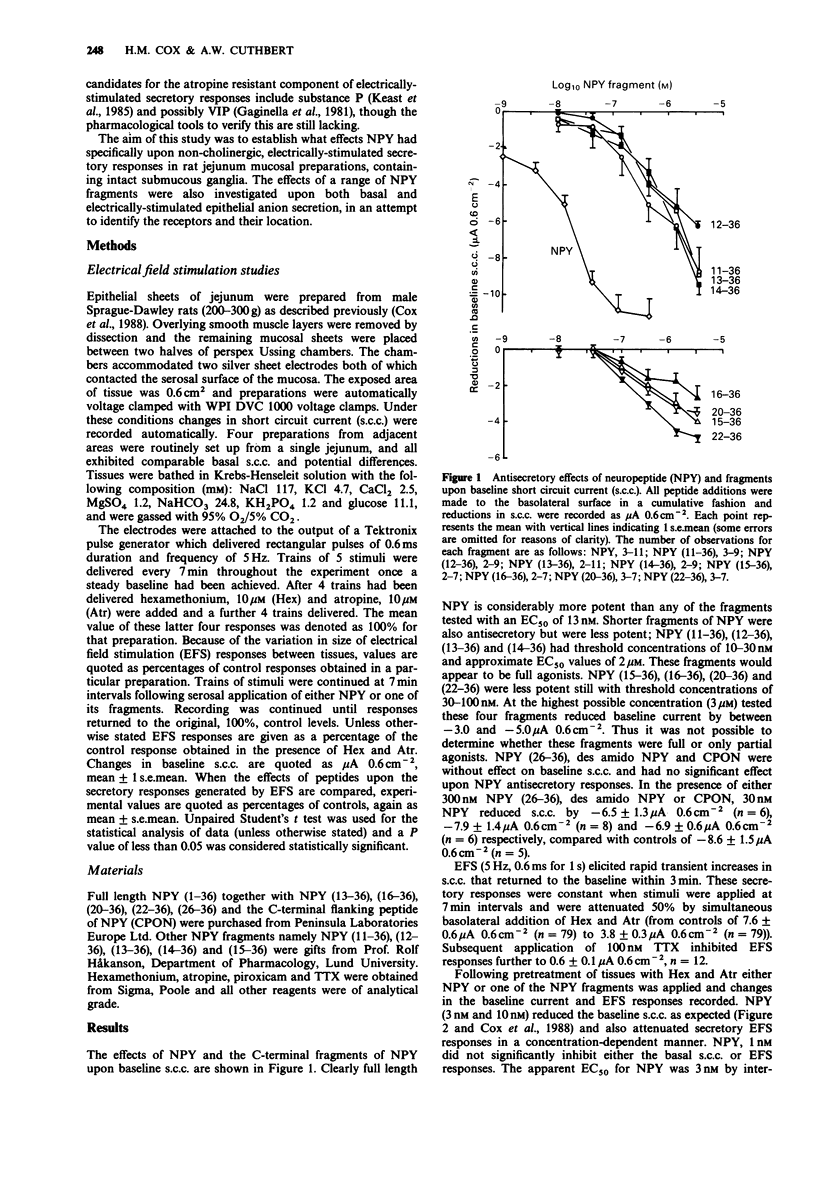
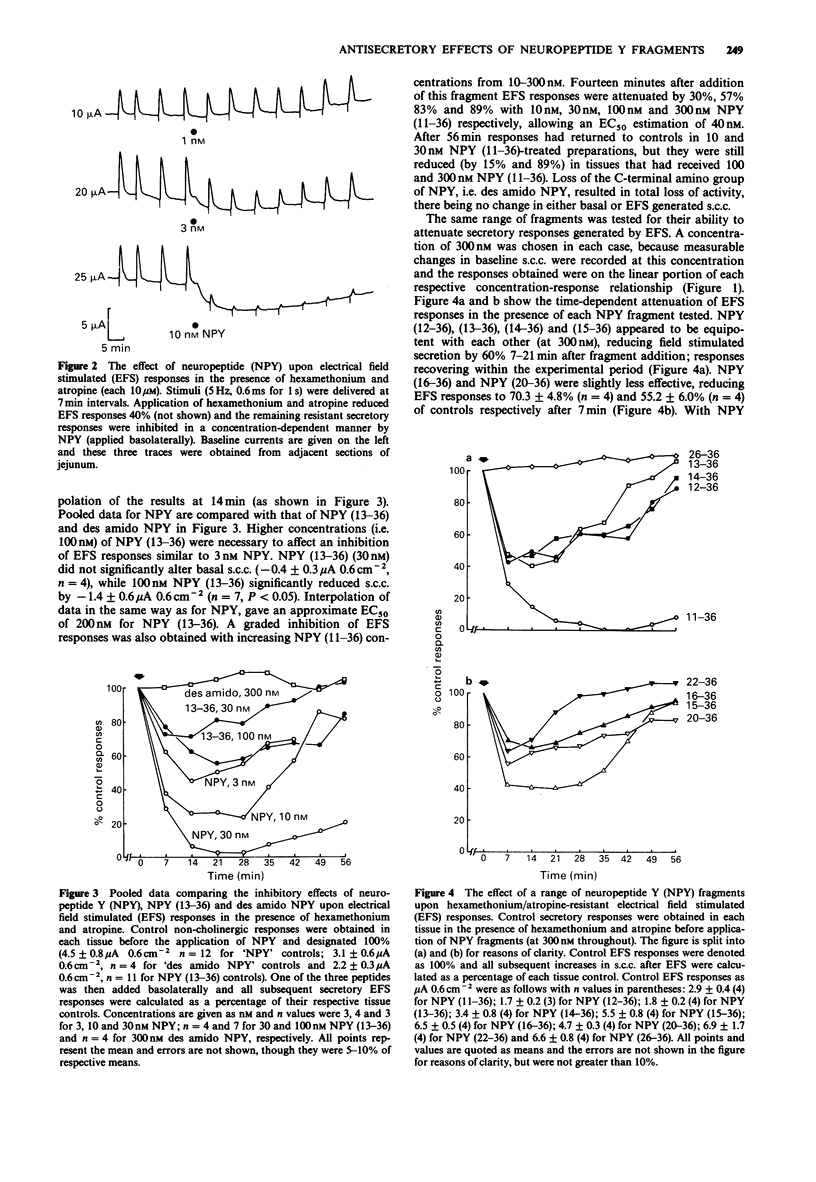
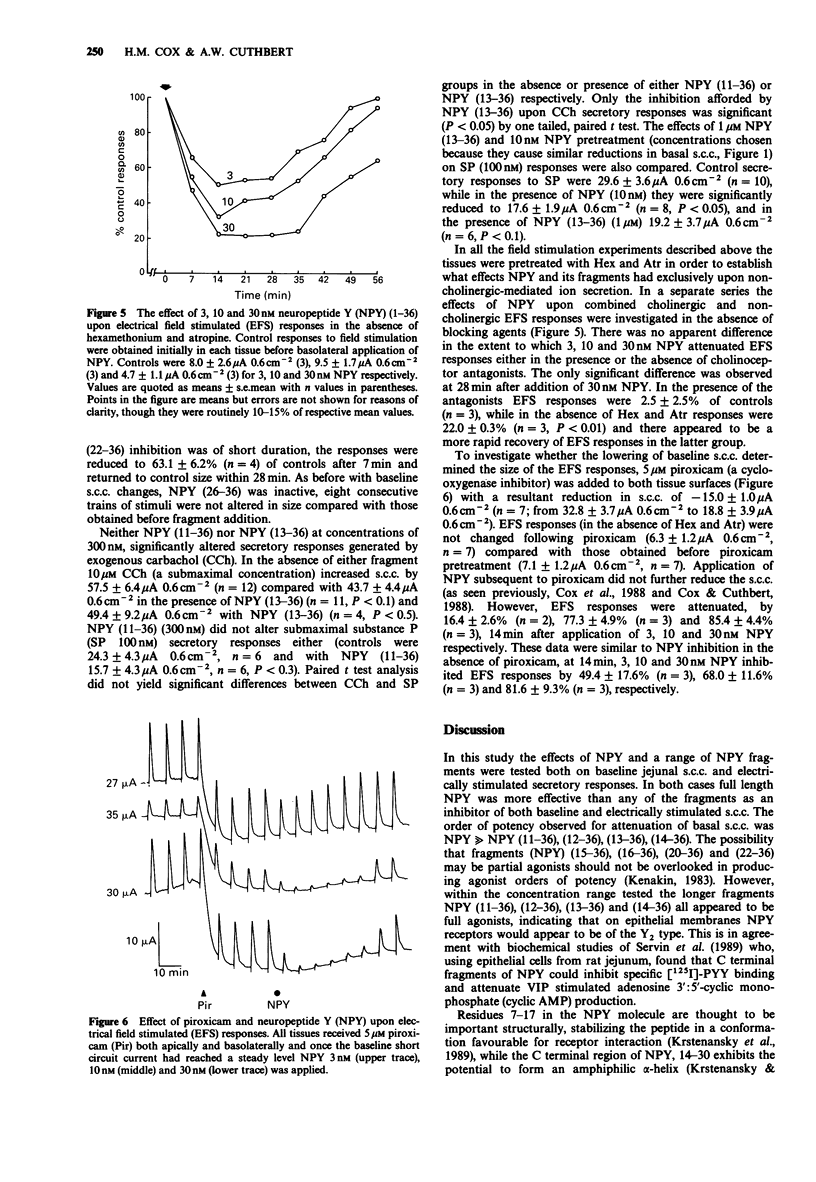
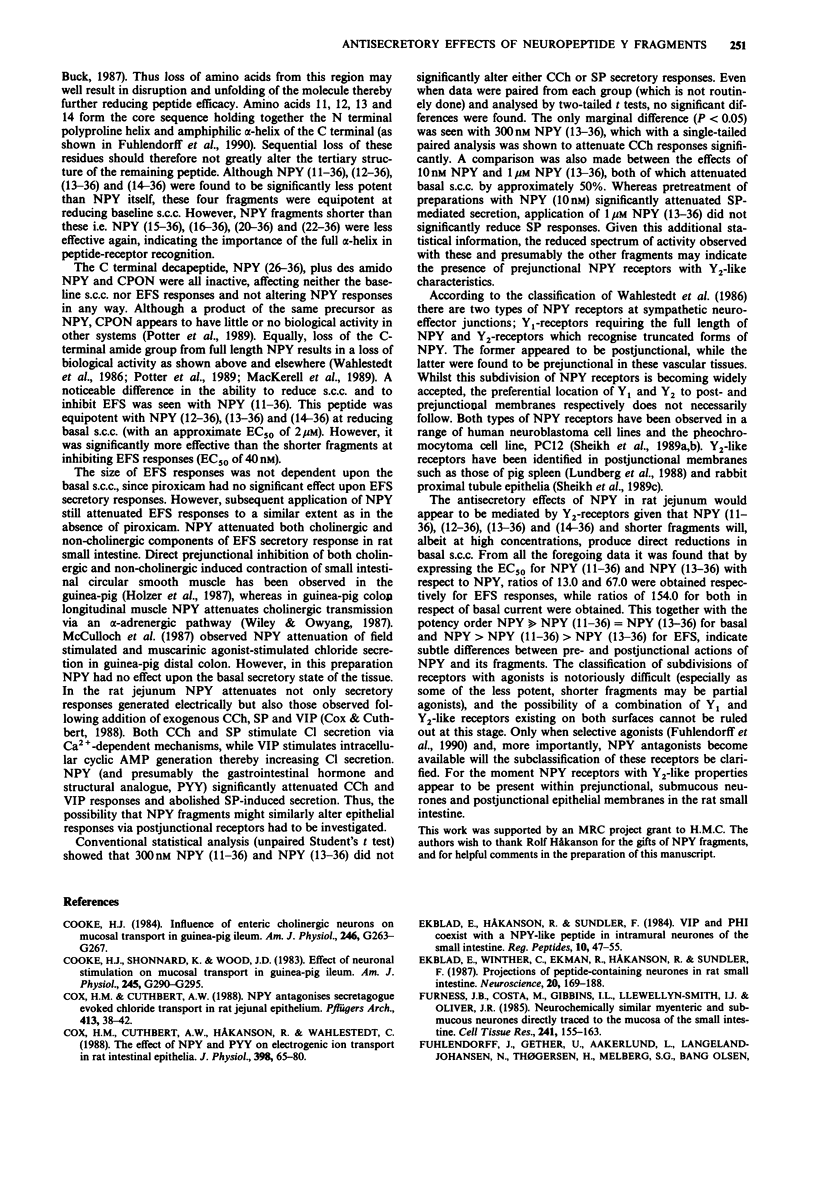
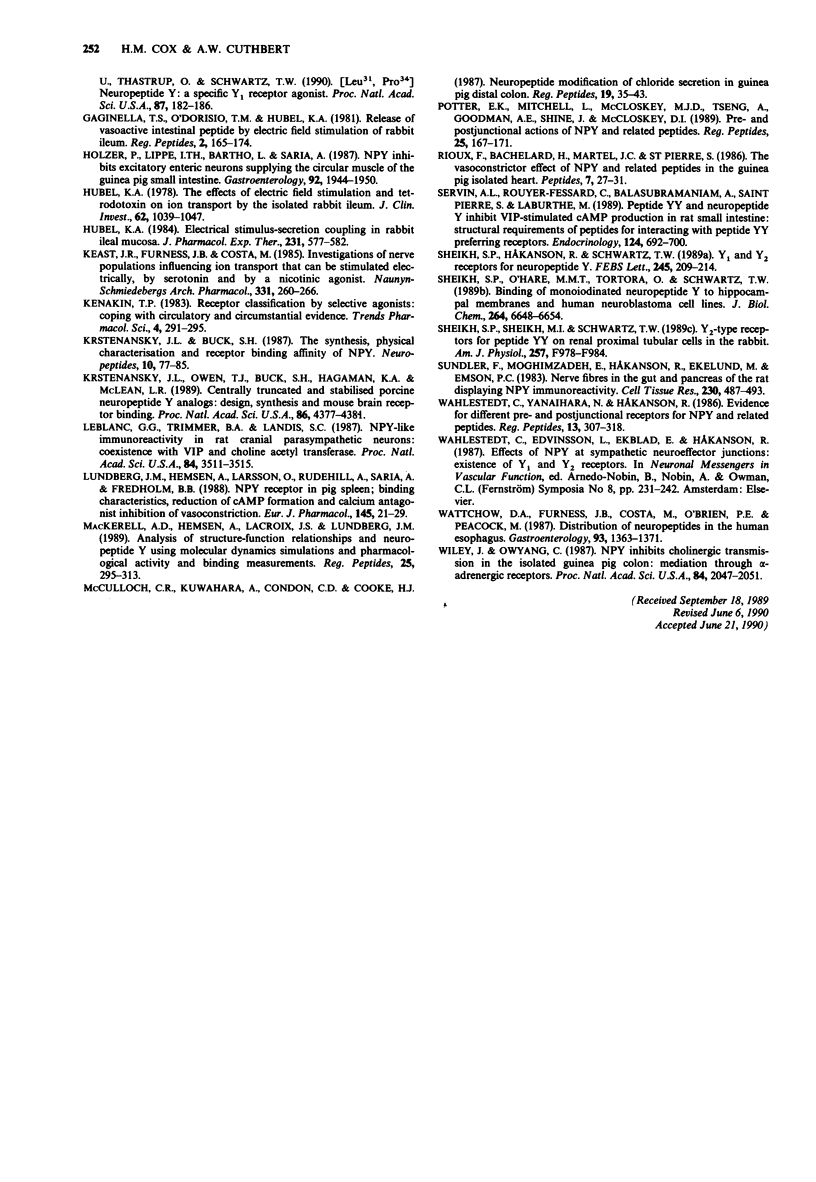
Selected References
These references are in PubMed. This may not be the complete list of references from this article.
- Cooke H. J. Influence of enteric cholinergic neurons on mucosal transport in guinea pig ileum. Am J Physiol. 1984 Mar;246(3 Pt 1):G263–G267. doi: 10.1152/ajpgi.1984.246.3.G263. [DOI] [PubMed] [Google Scholar]
- Cooke H. J., Shonnard K., Wood J. D. Effects of neuronal stimulation on mucosal transport in guinea pig ileum. Am J Physiol. 1983 Aug;245(2):G290–G296. doi: 10.1152/ajpgi.1983.245.2.G290. [DOI] [PubMed] [Google Scholar]
- Cox H. M., Cuthbert A. W., Håkanson R., Wahlestedt C. The effect of neuropeptide Y and peptide YY on electrogenic ion transport in rat intestinal epithelia. J Physiol. 1988 Apr;398:65–80. doi: 10.1113/jphysiol.1988.sp017029. [DOI] [PMC free article] [PubMed] [Google Scholar]
- Cox H. M., Cuthbert A. W. Neuropeptide Y antagonises secretagogue evoked chloride transport in rat jejunal epithelium. Pflugers Arch. 1988 Nov;413(1):38–42. doi: 10.1007/BF00581226. [DOI] [PubMed] [Google Scholar]
- Ekblad E., Håkanson R., Sundler F. VIP and PHI coexist with an NPY-like peptide in intramural neurones of the small intestine. Regul Pept. 1984 Dec;10(1):47–55. doi: 10.1016/0167-0115(84)90052-1. [DOI] [PubMed] [Google Scholar]
- Ekblad E., Winther C., Ekman R., Håkanson R., Sundler F. Projections of peptide-containing neurons in rat small intestine. Neuroscience. 1987 Jan;20(1):169–188. doi: 10.1016/0306-4522(87)90010-8. [DOI] [PubMed] [Google Scholar]
- Fuhlendorff J., Gether U., Aakerlund L., Langeland-Johansen N., Thøgersen H., Melberg S. G., Olsen U. B., Thastrup O., Schwartz T. W. [Leu31, Pro34]neuropeptide Y: a specific Y1 receptor agonist. Proc Natl Acad Sci U S A. 1990 Jan;87(1):182–186. doi: 10.1073/pnas.87.1.182. [DOI] [PMC free article] [PubMed] [Google Scholar]
- Furness J. B., Costa M., Gibbins I. L., Llewellyn-Smith I. J., Oliver J. R. Neurochemically similar myenteric and submucous neurons directly traced to the mucosa of the small intestine. Cell Tissue Res. 1985;241(1):155–163. doi: 10.1007/BF00214637. [DOI] [PubMed] [Google Scholar]
- Gaginella T. S., O'Dorisio T. M., Hubel K. A. Release of vasoactive intestinal polypeptide by electrical field stimulation of rabbit ileum. Regul Pept. 1981 Jun;2(3):165–174. doi: 10.1016/0167-0115(81)90010-0. [DOI] [PubMed] [Google Scholar]
- Holzer P., Lippe I. T., Barthó L., Saria A. Neuropeptide Y inhibits excitatory enteric neurons supplying the circular muscle of the guinea pig small intestine. Gastroenterology. 1987 Jun;92(6):1944–1950. doi: 10.1016/0016-5085(87)90628-7. [DOI] [PubMed] [Google Scholar]
- Hubel K. A. Electrical stimulus-secretion coupling in rabbit ileal mucosa. J Pharmacol Exp Ther. 1984 Dec;231(3):577–582. [PubMed] [Google Scholar]
- Hubel K. A. The effects of electrical field stimulation and tetrodotoxin on ion transport by the isolated rabbit ileum. J Clin Invest. 1978 Nov;62(5):1039–1047. doi: 10.1172/JCI109208. [DOI] [PMC free article] [PubMed] [Google Scholar]
- Keast J. R., Furness J. B., Costa M. Investigations of nerve populations influencing ion transport that can be stimulated electrically, by serotonin and by a nicotinic agonist. Naunyn Schmiedebergs Arch Pharmacol. 1985 Nov;331(2-3):260–266. doi: 10.1007/BF00634247. [DOI] [PubMed] [Google Scholar]
- Krstenansky J. L., Buck S. H. The synthesis, physical characterization and receptor binding affinity of neuropeptide Y (NPY). Neuropeptides. 1987 Jul;10(1):77–85. doi: 10.1016/0143-4179(87)90091-6. [DOI] [PubMed] [Google Scholar]
- Krstenansky J. L., Owen T. J., Buck S. H., Hagaman K. A., McLean L. R. Centrally truncated and stabilized porcine neuropeptide Y analogs: design, synthesis, and mouse brain receptor binding. Proc Natl Acad Sci U S A. 1989 Jun;86(12):4377–4381. doi: 10.1073/pnas.86.12.4377. [DOI] [PMC free article] [PubMed] [Google Scholar]
- Leblanc G. G., Trimmer B. A., Landis S. C. Neuropeptide Y-like immunoreactivity in rat cranial parasympathetic neurons: coexistence with vasoactive intestinal peptide and choline acetyltransferase. Proc Natl Acad Sci U S A. 1987 May;84(10):3511–3515. doi: 10.1073/pnas.84.10.3511. [DOI] [PMC free article] [PubMed] [Google Scholar]
- Lundberg J. M., Hemsén A., Larsson O., Rudehill A., Saria A., Fredholm B. B. Neuropeptide Y receptor in pig spleen: binding characteristics, reduction of cyclic AMP formation and calcium antagonist inhibition of vasoconstriction. Eur J Pharmacol. 1988 Jan 5;145(1):21–29. doi: 10.1016/0014-2999(88)90344-5. [DOI] [PubMed] [Google Scholar]
- MacKerell A. D., Jr, Hemsén A., Lacroix J. S., Lundberg J. M. Analysis of structure-function relationships of neuropeptide Y using molecular dynamics simulations and pharmacological activity and binding measurements. Regul Pept. 1989 Jun-Jul;25(3):295–313. doi: 10.1016/0167-0115(89)90178-x. [DOI] [PubMed] [Google Scholar]
- McCulloch C. R., Kuwahara A., Condon C. D., Cooke H. J. Neuropeptide modification of chloride secretion in guinea pig distal colon. Regul Pept. 1987 Oct;19(1-2):35–43. doi: 10.1016/0167-0115(87)90072-3. [DOI] [PubMed] [Google Scholar]
- Potter E. K., Mitchell L., McCloskey M. J., Tseng A., Goodman A. E., Shine J., McCloskey D. I. Pre- and postjunctional actions of neuropeptide Y and related peptides. Regul Pept. 1989 May;25(2):167–177. doi: 10.1016/0167-0115(89)90258-9. [DOI] [PubMed] [Google Scholar]
- Rioux F., Bachelard H., Martel J. C., St-Pierre S. The vasoconstrictor effect of neuropeptide Y and related peptides in the guinea pig isolated heart. Peptides. 1986 Jan-Feb;7(1):27–31. doi: 10.1016/0196-9781(86)90056-2. [DOI] [PubMed] [Google Scholar]
- Servin A. L., Rouyer-Fessard C., Balasubramaniam A., Saint Pierre S., Laburthe M. Peptide-YY and neuropeptide-Y inhibit vasoactive intestinal peptide-stimulated adenosine 3',5'-monophosphate production in rat small intestine: structural requirements of peptides for interacting with peptide-YY-preferring receptors. Endocrinology. 1989 Feb;124(2):692–700. doi: 10.1210/endo-124-2-692. [DOI] [PubMed] [Google Scholar]
- Sheikh S. P., Håkanson R., Schwartz T. W. Y1 and Y2 receptors for neuropeptide Y. FEBS Lett. 1989 Mar 13;245(1-2):209–214. doi: 10.1016/0014-5793(89)80223-6. [DOI] [PubMed] [Google Scholar]
- Sheikh S. P., O'Hare M. M., Tortora O., Schwartz T. W. Binding of monoiodinated neuropeptide Y to hippocampal membranes and human neuroblastoma cell lines. J Biol Chem. 1989 Apr 25;264(12):6648–6654. [PubMed] [Google Scholar]
- Sheikh S. P., Sheikh M. I., Schwartz T. W. Y2-type receptors for peptide YY on renal proximal tubular cells in the rabbit. Am J Physiol. 1989 Dec;257(6 Pt 2):F978–F984. doi: 10.1152/ajprenal.1989.257.6.F978. [DOI] [PubMed] [Google Scholar]
- Sundler F., Moghimzadeh E., Håkanson R., Ekelund M., Emson P. Nerve fibers in the gut and pancreas of the rat displaying neuropeptide-Y immunoreactivity. Intrinsic and extrinsic origin. Cell Tissue Res. 1983;230(3):487–493. doi: 10.1007/BF00216194. [DOI] [PubMed] [Google Scholar]
- Wahlestedt C., Yanaihara N., Håkanson R. Evidence for different pre-and post-junctional receptors for neuropeptide Y and related peptides. Regul Pept. 1986 Feb;13(3-4):307–318. doi: 10.1016/0167-0115(86)90048-0. [DOI] [PubMed] [Google Scholar]
- Wattchow D. A., Furness J. B., Costa M., O'Brien P. E., Peacock M. Distributions of neuropeptides in the human esophagus. Gastroenterology. 1987 Dec;93(6):1363–1371. doi: 10.1016/0016-5085(87)90267-8. [DOI] [PubMed] [Google Scholar]
- Wiley J., Owyang C. Neuropeptide Y inhibits cholinergic transmission in the isolated guinea pig colon: mediation through alpha-adrenergic receptors. Proc Natl Acad Sci U S A. 1987 Apr;84(7):2047–2051. doi: 10.1073/pnas.84.7.2047. [DOI] [PMC free article] [PubMed] [Google Scholar]


